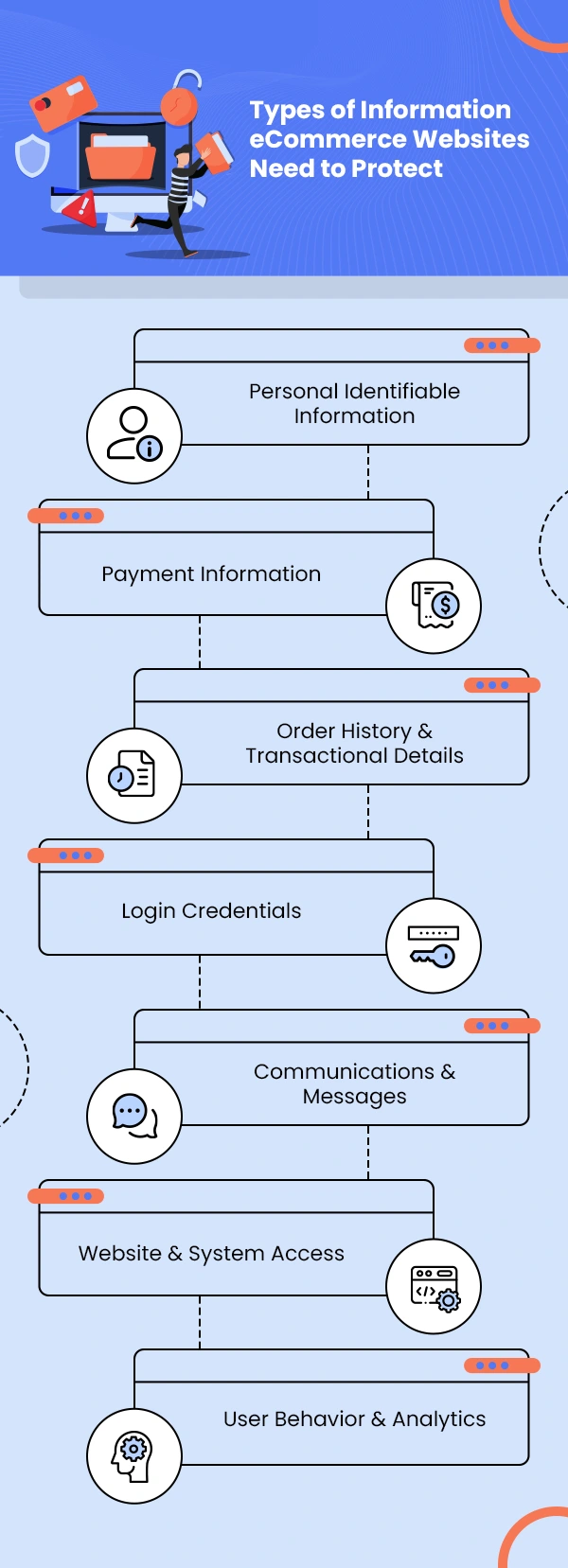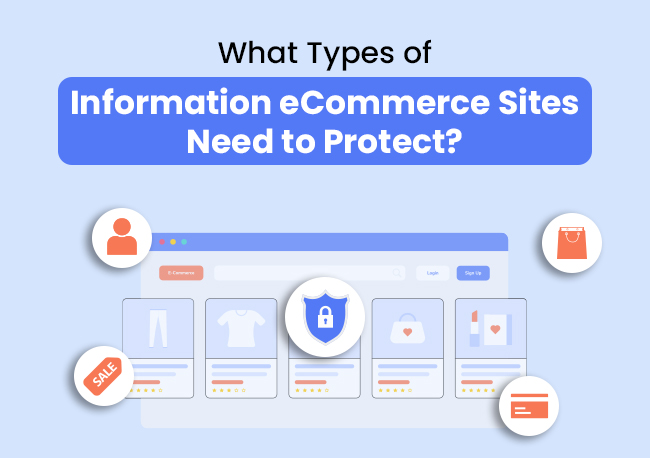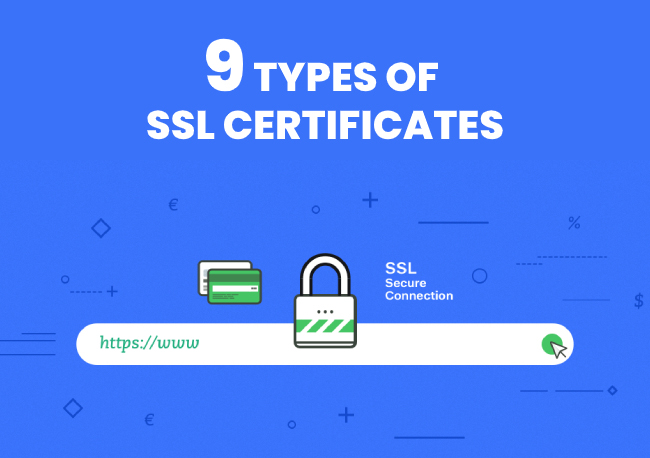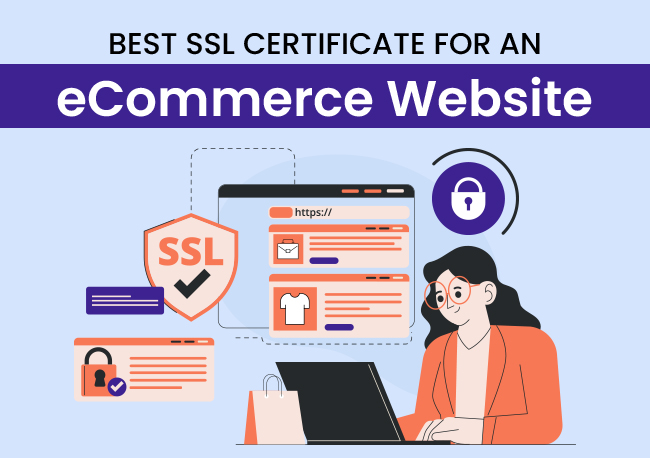“Trust and convenience comes with great responsibilities.”
This quote plays a significant role in the digital realm of eCommerce.
For years, eCommerce websites have been a touch point for shoppers seeking convenience and a wide range of products. From buying daily groceries to shopping for a special occasion, this online hub delivers everything you need.
While eCommerce websites have been an integral part of consumers, it is important to recognize that they impact businesses alike.
For eCommerce business owners, digital retail is more than a virtual marketplace. It is also a data repository collecting valuable information about users to enhance their shopping and browsing experience. And safeguarding this data is a priority.
However, how to determine which details are to be preserved? Well, to know that read this write-up until the end.
Importance of eCommerce Security
Security has been a primary concern for website owners, especially eCommerce ones.
Why eCommerce, you ask?
Because they collect user information such as contact details, card details, bank details, and similar other personal data, that has to be protected against unwanted cyber attacks such as phishing, malware, DoS, SQL injection, and password cracking.
Cyber attacks strike websites every 39 seconds, with 2,200 attacks occurring every day, says Astra. These statistics become all the more reason why prioritizing website security is important while building an eCommerce website.
- Reputable web hosting services
- Strong passwords
- Standard payment processing system
- An SSL certificate
- A Web Application Firewall (WAF)
- The right coding practices
- Frequent backups and updates
eCommerce security is not limited to protection against security breaches. Following the best website security practices equates to laying a foundation of trust, eventually leading to building a reputation among your customers. It also mitigates financial risk, secures IP rights, and ensures the long-term sustainability of your online business.
Since you know the importance of eCommerce security, let’s jump right to the reason for drafting this blog.
Also Read: Types Of eCommerce Websites And Models
Types of Information eCommerce Websites Need to Protect
1. Personal Identifiable Information
The foremost aspect you must safeguard is Personal Identifiable Information, aka PII. Generally, this segment will include details like names, addresses, contact numbers, email addresses, and government-issued identification numbers such as Aadhar card and PAN card.
You need to ensure all the information of users collected by your eCommerce website is protected with effective security measures to prevent identity theft and fraud.
This is why prioritize data minimization, access control, sew security patches, draft clear privacy policies, and remember to abide by the General Data Protection Regulation (GDPR) laws.
2. Payment Information
The next in line is payment information. Cards, CVV codes, UPI numbers, expiration dates, bank details, and other payment information are extremely sensitive and should not be compromised.
You need to ensure your eCommerce website adheres to the regulations and policies set forth by PCI DSS to improve the payment ecosystem for consumers and minimize the misuse of such non-public information.
Furthermore, you must consider other fundamental tactics like partnering with authorized & trusted payment processors, tokenizing before every transaction, and building a powerful & secure network infrastructure.
Monitoring online and offline transactions by leveraging real-time insights and anomaly detection is advised.
Also Read: 17 Top Technical Requirements For Your eCommerce Websites
3. Order History & Transactional Details
You might wonder why you even need to encrypt order history and transactional details. These details can say a lot about the shopper. From shopping preferences to habits and even purchase patterns, everything can be revealed through such information, which hackers use as bait to lure, blackmail, and exploit customers.
Hence, shield these confidential details and restrict access to personnel only. Don’t forget to implement Data Loss Prevention (DLS). Make sure to follow the right development practices to safeguard from even minute vulnerabilities.
4. Login Credentials
Securing the login credentials of your eCommerce website users is as crucial as protecting the passwords of your social media and financial accounts. You need to encrypt usernames, passwords, and security questions & answers to steer clear of unwanted users and attacks.
For better security, enabling two or multi-factor authentication is recommended. Doing so will enhance security and allow your users to reject intruders.
Always remember to encourage strong password practices. Meaning your eCommerce website should only permit passwords that are 8-12 characters long with a mix of uppercase, lowercase, numerals, and symbols. This ensures your website and its stored information are immune against brute force attacks.
5. Communications & Messages
Imagine this: What if a stranger could read the messages, access personal information, images, videos, and intercept the sensitive data shared between you and your customers?
Just the thought of such a scenario is a complete nightmare; if it ever becomes a reality, it could cause significant hard-to-mend damages.
Thus, ensure taking necessary security measures like end-to-end encryption, Public Key Infrastructure (PKI), VPN, TLS/SSL certificate, strong passwords, One Time Pin (OTP), two or multi-factor authentication, and secure email services.
Besides these steps, it’s essential to keep your website up-to-date and avoid sharing information with untrusted sources.
Also Read: How Can You Make A Website Look More Professional?
6. Website & System Access
Apart from you and your end users, there might be other entities who can access your eCommerce website for easier management. However, if you don’t limit access or enable permitted-only users, your private spectrum will turn into public and end up in the wrong hands.
Therefore, implement strong password policies, limit permissions, encrypt data, install a firewall, monitor the logging mechanisms, and conduct security checks at regular intervals.
We also suggest utilizing physical security and mapping out a contingency plan for disaster recovery.
7. User Behavior & Analytics
We all are familiar with how analytics can track the smallest of details, including user interactions, sessions, experience, and conversion rates. If mishandled or exposed, it can lead to privacy breaches and reputational damage.
Although, a few security mechanisms need to be considered, such as data anonymization or pseudonymization, encrypting the database, taking consent of users by agreeing to privacy policies, using reliable analytics tools, conducting regular data audits, and tracking unusual activity on the websites.
All these factors will not only help you build credibility among your users but also ensure data privacy and protect user behavior, thereby enhancing your website’s reputation.
So far, we gave you comprehensive details on the importance of eCommerce security and the types of information that requires to be protected. We will move forward to our next pointer – How can you protect your eCommerce customer information?
Let’s have a recap of what we learned about the types of information your eCommerce website needs to be fully protected below:

Also Read: Website Optimization Tips To Increase Website Performance
Tips to Protect eCommerce Customer Information
1. Install SSL Certificate
The first tip is to switch HTTP to HTTPS. Generally, when you launch your website on the internet, you get HTTP as a default to communicate securely with your end users. However, HTTP is not the ideal choice, especially when you collect user information and interact at frequent intervals.
This is when installing an SSL certificate comes into the picture. The ‘S’ in HTTPS signifies security, ensuring all your communications and data will remain confidential and not be easily intercepted by hackers or unwanted attackers.
To enable HTTPS on your eCommerce website, contact your hosting provider. Usually, the hosting provider will offer a free SSL certificate on your package. However, if it is paid, check out the price and choose the one that fits best with your needs.
Also Read: Which SSL Certificate Is Best For An eCommerce Website?
2. Implement Two or Multi-Factor Authentication
The next tip is to enable two or multi-factor authentication for your user’s account. Basically, two or multi-factor authentication works like an added layer of security that will keep all fraudsters and unwanted people at bay.
Once you implement it for your website, users’ login credentials and other crucial information will be protected and only be accessible when users input the OTP sent to their mobile or mail by your server.
Two or multi-factor authentication is not merely limited to a one-time passcode. You can also ask users to set a question and answer or add biometrics such as fingerprint, face, or retina.
3. Use Secure Payment Gateways
Always remember to go for secured and authorized payment gateways. Digital payments have become a go-to medium to purchase anything. Users always look forward to using a seamless and risk-free online transaction service. Hence, choosing a robust, safe, and trusted platform should be your priority to gain the confidence of your shoppers.
Ensure the eCommerce transaction system complies with the regulations set forth by the PCI/DSS to avoid potential fines and shield your reputation.
4. Keep Regular Security Audits
Regardless of all the firewalls, SSL certificates, and security measures you have taken into account, conducting security audits at frequent intervals is a must. You must keep an eye on the internal, second-party, such as WordPress plugins, and third-party audits, such as payment gateways, to identify and resolve potential vulnerabilities immediately.
Besides the routine audits, ensure to conduct event-based audits after launching features, major updates, or facing any attack to assure there are no risks.
Also Read: 9 Types Of SSL Certificates – Make The Right Choice
5. Don’t Forget Data Encryption
Another tip for you would be to encrypt your data using the cryptography method. Generally, this technique allows you to conceal confidential information by transforming it into codes that can only be perceived by the creator and the intended user.
Doing so will secure and encrypt your communication from hackers and malicious third parties. Now, you might be wondering how cryptography works. It simply swaps the first letter of the alphabet from the last letter. For instance, A is replaced with Z and B with Y.
Here’s what data encryption looks like –
GOOD MORNING, HAVE A NICE DAY
TLLW NLINRNMT, SZDV Z MRXV WZB
6. Incorporate Strong Passwords
Creating a strong password is the most standard yet useful practice you must follow. You should encourage your users to write complex passwords using words, numerals, and special characters. Passwords should be at least 8 characters, which must be updated from time to time. Additionally, password or passcode attempts should not be more than three times for security concerns.
Implementing this practice will make it difficult for hackers and malicious attackers to crack passwords.

7. Keep Regular Backups
Never, we repeat, never forget website backups. Backups are like the best friend of your digital life that will always be right by your side, especially when you need a helping hand.
Hence, take backups at regular intervals and be ensure to take event-based backups. Create a copy of your website upon every major and minor change or launch of a feature or functionality.
Even if you lose the data or the updated website, your guardian angel will swoop in to save your day like nothing happened. Moreover, your backup bestie will not cause any security issues or experience hiccups.
Also Read: 10 Common Reasons For A Website Crash
8. Limit the Access
We know website management is not a one-man job. Several aid-mates are included to carry out the operations efficiently. However, that does not mean you will make your website accessible to all. You need to make sure that only authorized personnel are allowed to access the website.
Limiting access is one way to do so. You can implement role-based access controls and assign tasks accordingly, which will not only allow your team to focus on their expertise but also improve the security of your website since unauthorized users are not permitted to enter the infrastructure of your website.
9. Draft a Privacy Policy
Last but not least is drafting a clear and comprehensive website privacy policy. A privacy policy is basically a statement comprising information on how a visitor’s data is collected, stored, handled, and used by the website. This privacy policy is created to safeguard all the information shared by users, including name, address, contact details, account numbers, and so on.
Create a detailed and easy-to-understand policy to maintain transparency and business credibility. This policy is equally significant for legal compliance and data protection as it highlights that your website abides by the rules of the GDPR and other data & consumer protection laws.
10. Always Stay Updated
Keep your eCommerce website updated with the latest and compatible version, including plugins, third-party software, themes, and similar extensions. Outdated versions can raise security concerns and make your website vulnerable to attacks.
Thus, make sure your website is up to date, and if you find any errors, patch them immediately to shield from SQL injection attacks, DDoS, and more.
Let’s have a recap of what we learned about the ways to secure your eCommerce website below:

Also Read: 7 Best CMS For Building An eCommerce Website
Frequently Asked Questions
Below are a few security vulnerabilities in eCommerce websites –
➔ Missing security headers (HTTPS)
➔ Weak authentication process
➔ outdated software & plugins
➔ Improper session handling
➔ Security misconfigurations
➔ Cross-site request forgery
➔ Digital payment frauds
➔ Insecure file uploads
➔ Cross-site scripting
➔ SQL Injection
Here are the best plugins and tools recommended for eCommerce websites –
➔ Sucuri Security
➔ iThemes Security
➔ Wordfence Security
➔ Cloudflare
➔ Akismet
➔ WPScan
➔ Netsparker
➔ All In One WP Security & Firewall
➔ Bulletproof Security
➔ Qualys SSL Labs
➔ Google reCAPTCHA
➔ VaultPress
According to the Cybersecurity Center of Excellence, AI/ML innovations, modern payment innovations, Real User Monitoring (RUM), E-Skimming, and credential shuffling attacks are the 5 latest trends and advancements strategies for eCommerce security.
Yes, if you have an eCommerce website, you must be compliant with the regulations of –
➔ Payment Card Industry Data Security Standard (PCI/DSS)
➔ ISO/IEC 27001
➔ ISO/IEC 27018
➔ CERT-In (Indian Computer Emergency Response Time)
➔ RBI Guidelines
➔ TRAI Guidelines
➔ Indian IT Act, 2000
➔ Data Protection Laws
In the End,
While it may be challenging to stop hackers from hacking websites, you can definitely take some proactive measures to safeguard confidential data. You can implement the above-mentioned tips and tricks to enhance the security of your eCommerce website and eliminate the risk of unauthorized access and data compromise.



